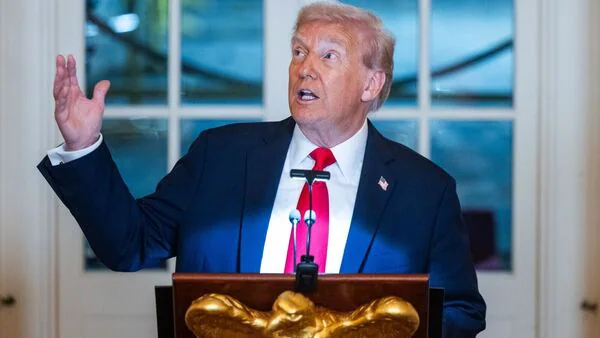
Trump Admin Prepares Backup Tariff Plans Ahead Of Supreme Court Judgement - What Options Are Available?
The Commerce Department and the Office of the US Trade Representative have analysed other options in case the court rules against the tariffs, Bloomberg reported, citing US officials familiar with the development.
What options are available to the Trump administration?The White House is exploring alternatives, such as Section 301 and Section 122 of the Trade Act, which provide the president with the unilateral power to impose duties.
Section 301 is a law that grants the US Trade Representative the authority to investigate and address unfair trade practices by foreign countries that harm US commerce. Section 122 powers would let the president impose 15% tariffs, a threshold he has agreed upon in various negotiations, but only for up to 150 days
These methods, however, typically tend to be either slower or more limited than the broad powers Trump has used so far and are likely to face their own legal challenges.
The US administration still hopes to win the case as Trump has repeatedly urged to uphold his tariffs on trading partners.
Also Read | Will tariffs impact US inflation? Fed's Anna Paulson answersThese preparations, however, hint that the administration is preparing for a potentially unfavourable outcome, after the court earlier expressed scepticism over Trump's country-based tariffs. It further reflects Trump's determination to impose tariffs, even through unused means. Tariffs remain a core part of the US President's agenda, regardless of the court's decision, an official told the news portal.
“We're waiting for a decision. We hope it's going to be good, but if it's not, we'll do - we always find ways, you know, we find ways,” Trump said Wednesday.
The White House acknowledged it's seeking“new ways” to maintain Trump's trade policy, while not sharing specifics of the plan.
White House hopes for a victory“President Trump lawfully exercised the emergency tariff powers granted to the Executive Branch by Congress, and the Administration is confident in ultimate victory on this matter by the Supreme Court. The Administration is always examining new ways to address America's historic goods trade deficit and reshore the manufacturing that's critical to our national and economic security,” spokesman Kush Desai told Bloomberg.
It remains uncertain when the Supreme Court will deliver its ruling. The justices might uphold the tariffs, remove them entirely, or adopt a more focused approach. The decision risks adding further unpredictability for businesses and foreign governments.
The Supreme Court case centres on Trump's utilisation of the International Emergency Economic Powers Act, or IEEPA, under which he has imposed the reciprocal tariffs on imports globally, as well as levies on Chinese, Canadian, and Mexican goods related to fentanyl and a charge on products from Brazil in an unsuccessful attempt to stop the prosecution of former president and Trump ally Jair Bolsonaro.
Also Read | Trump's tariff retreat on groceries exposes the flaws of his trade strategyThe total effective tariff rate on US imports is approximately 14.4%, with more than half of that attributed to IEEPA duties, according to Bloomberg Economics' estimates. The economists“expect most duties to eventually be fully replaced” if the Supreme Court wipes out the country-based levies.
Meanwhile, backup plans are already being implemented in certain cases. Trump has initiated a 301 investigation against Brazil, for example, and has imposed 301 tariffs on certain Chinese products from his first term. Typically, this provision necessitates an extensive investigation before duties can be imposed.
National Economic Council Director Kevin Hassett stated that Trump might invoke 301 or 122 authorities to reapply import tariffs if the Supreme Court rules against the administration.
“There are a lot of things that we could do so that we could reproduce the policies that we have right now with alternative authorities,” Hassett said during an earlier interview with Bloomberg.
Trump has utilised Section 232 of the Trade Expansion Act to impose tariffs on industries such as metals and autos. The administration has initiated new investigations and introduced additional duties. Furthermore, the ongoing inclusion of finished products under these tariffs has upset certain trading partners, including the European Union, which argues that it violates the agreed-upon limits on sector-specific tariffs within the US-European Union trade agreement.
Also Read | Trump tariff exemptions: Indian tea, coffee and spice exporters stand to benefitSection 338 of the Tariff Act is another possible option for Trump, but one that might be open to a new legal challenge, since it has never been used before. The provision grants the US President the power to impose tariffs of up to 50% or exclude imports from a country that engages in discriminatory practices against the US.
What are the concerns with other alternatives?The new measures will be more difficult for Trump to implement due to their limitations. Officials would need to address complex legal questions, such as whether the administration could impose Section 122 tariffs simultaneously, cancel them before their deadline, and then reimpose them under a new timeframe, or whether to apply duties retroactively to avoid refunding money collected under the current system.
An adverse court ruling could force the administration to give back more than $88 billion in duties already collected, according to Bloomberg Economics.
Legal Disclaimer:
MENAFN provides the
information “as is” without warranty of any kind. We do not accept
any responsibility or liability for the accuracy, content, images,
videos, licenses, completeness, legality, or reliability of the information
contained in this article. If you have any complaints or copyright
issues related to this article, kindly contact the provider above.

















Comments
No comment